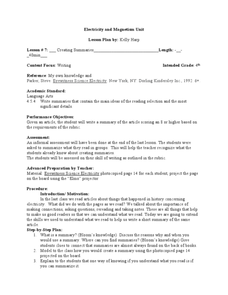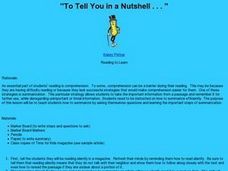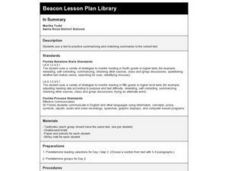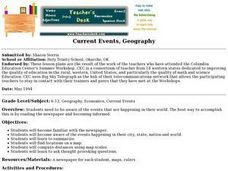Curated OER
Reading to Learn: How Do We Sum That Up?
Students explore the topic of summarizing. They read the book, Dolphins at Daybreak, to practice summarizing. They determine what information is important and choose sentences to summarize the passages they read. They write a summary...
Curated OER
Summary, Note Taking, Main Idea and Details
Pupils take notes from oral readings and lectures to create a summary of the material. They use different sizes of post-it notes to complete the activity. They practice pulling the main ideas out of the given material.
Curated OER
Communication Skills
Young scholars practice and model good listening skills, become aware of the effects of cultural and other biases that affect communication.
Curated OER
Creating Summaries
Fourth graders generate written summaries from non-fiction articles. In this writing lesson, 4th graders determine what must be included in writing a good summary and then work in small groups to construct summaries after reading...
Curated OER
Let's Sum It All Up
Fourth graders watch a modeled instructional activity on summarizing the main ideas of a non-fiction passage. They silently read a passage about sharks before making a class summarization chart. Next, they read a small passage and...
Curated OER
To Tell You in a Nutshell
Students discuss the importance of comprehension and the use of summarization. Through guided practice, they follow six steps in finding and highlighting important information from an article, while deleting information that is not...
Curated OER
Tell Me All About It!!
Students discuss the importance of comprehension and the use of summarization. Through guided practice, they follow five steps in finding and highlighting important information, while deleting information that is not needed. Using the...
Curated OER
Tell Me All About It!
Students discuss the importance of comprehension and the use of summarization. Through guided practice, they follow three rules in finding and highlighting important information, while crossing out information that is not needed. Using...
Curated OER
Summin' It All Up
Young scholars, through teacher modeling and guided practice, explore the five steps/rules of summarizing. Independently, they read a short article and apply the summarization rules and skills (picking out key words, main points, etc.)...
Curated OER
Break It Down!
Young scholars practice the strategy of summarization in order to comprehend a text. They drill on how to delete unimportant information, repeated information and substitute easy terms for lists of items. Each student receives a copy of...
Curated OER
Wanted: Only the Facts!
Learners apply three steps to summarizing successfully (delete trivial and redundant material, replace superordinate terms with a list or action term, and invent a topic sentence.) Through guided practice, they follow these rules in...
Curated OER
Sum it Up!!
Students work to develop comprehension strategies. Through modeling they discover how to summarize a written passage by deleting unnecessary information and using clustering or concept mapping for the most important items or events. In...
Curated OER
What's Important?
Students, through teacher modeling and guided practice, explore four steps/rules of summarizing. In groups, they read a short passage and then, by applying the summarization rules and skills, write an effective summary of it.
Curated OER
Simple Steps to Sum It Up!
Students review six steps to follow to correctly summarize a written passage. Through modeling, guided and independent practice they distinguish between unimportant and important information and summarize an article using these steps.
Curated OER
Short But Important
Students review the concept of silent reading. They listen to an article and, through guided practice and modeling, create a concept map of what they hear. Then, in groups of two, they read another article on their own and map it the...
Curated OER
Summing up Winter!
Students review the concept of silent reading. Through modeling and guided practice, they follow four given steps in summarizing the beginning of a written passage. Then they continue to read the passage independently and follow the same...
Curated OER
Sum It Up to Learn the Most!
Students review the concept of silent reading. Through modeling and guided practice, they follow six given steps in summarizing a written passage. Then they read a passage independently and follow the same steps in summarizing the...
Curated OER
In Your Own Words...
Learners discuss the importance of comprehension and the use of summarization. Through guided practice, they summarize given paragraphs. Independently, they read an article and highlight information that they believe is very important....
Curated OER
That Sums It All Up!
Pupils review the concept of silent reading. They listen to a story and create a story map of what they hear. Then, they read their own story and map it the same way. This time, they use this story map to write a summary of what they...
Curated OER
Paraphrase/Summarize Relay
Fifth graders internalize the ability to recall, inform, or organize ideas when comprehending text. Students practice paraphrasing/summarizing by taking it to the playground. Students line up with 4B5 feet on each side of the group,...
Curated OER
Writing About Pearl Harbor
Students summarize the reasons why the U.S. entered World War 2. They view a video on the bombing of Pearl harbor, construct a timeline of WWII events, and evaluate propaganda posters to create their analysis of the start of U.S....
Curated OER
In Summary
Fourth graders read selections from library books and summarize what they read. They listen to a summary and guess which paragraph the student is summarizing.
Curated OER
Geo Jammin' By DeSign - Day 7, Lesson 37: Summarizing for the Summative
Students listen for specific information during summary presentations. They practice giving feedback on given topic according to a set of standards. The speaker reports to the rest of class from a report and listeners determine if...
Curated OER
Current Events, Geography
Students read the newspaper to become aware of what is happening in their city, state, nation, and world. They summarize, find locations on a map and ask thought-provoking questions.

























